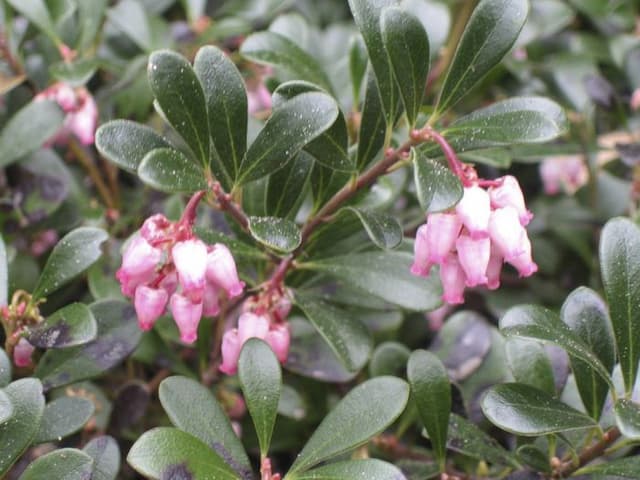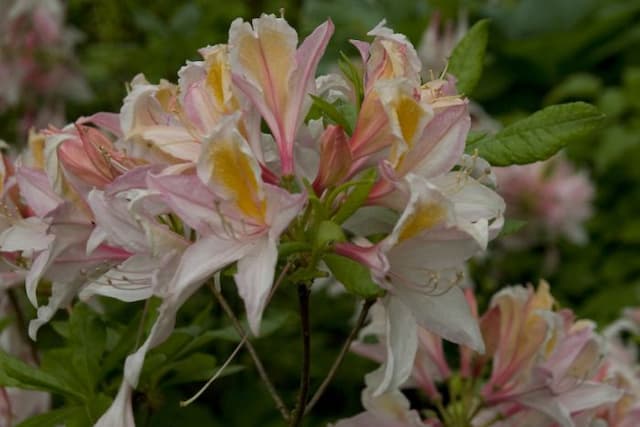Rhododendron Rhododendron 'Egret'

ABOUT
The Rhododendron 'Egret' is a visually striking plant that is a member of the rhododendron family. It is known for its lush foliage and spectacular floral displays. The leaves of this plant are dark green, glossy, and evergreen, providing a beautiful backdrop year-round. Each leaf is elliptical in shape, boasting a leathery texture, which can create a dense, bushy appearance. In terms of flowers, the 'Egret' is particularly breathtaking when it blooms. The flowers are typically large and showy, with a funnel shape that is characteristic of the family. They come in clusters, known as trusses, which can contain several individual blooms. The color of the flowers tends to be a delicate shade, often white or lightly tinged with pink, which stands out beautifully against the dark green leafy canvas. The petals may exhibit a subtle waviness at the edges and often display a contrast of color in the throat of the blossom, such as yellow or greenish markings. The overall presentation of the Rhododendron 'Egret' is one of elegance and striking beauty, with its flowers providing a lush and vibrant spectacle that can liven up any garden space. Despite the exclusion of specific size dimensions, it bears mentioning that it is the type of plant that can serve as a stunning focal point due to its floral abundance and ornamental leaves.
About this plant
 Names
NamesFamily
Ericaceae
Synonyms
Egret Rhododendron
Common names
Rhododendron 'Egret'
 Toxicity
ToxicityTo humans
Rhododendron is toxic to humans. All parts of the plant contain substances known as grayanotoxins. If ingested, these toxins can cause symptoms such as nausea, vomiting, drooling, diarrhea, blurred vision, headaches, and can lead to a potentially fatal drop in blood pressure and cardiac rhythm disturbances if eaten in large quantities.
To pets
Rhododendrons are also toxic to pets, including dogs, cats, and horses. Like in humans, ingestion of any part of the plant can lead to poisoning. Symptoms of toxicity in pets may include drooling, vomiting, diarrhea, weakness, and potentially, coma or death if a significant amount is consumed. Immediate veterinary attention is recommended if a pet ingests Rhododendron.
 Characteristics
CharacteristicsLife cycle
Perennials
Foliage type
Evergreen
Color of leaves
Green
Flower color
White
Height
5 feet (1.5 meters)
Spread
5 feet (1.5 meters)
Plant type
Shrub
Hardiness zones
5
Native area
Asia
Benefits
 General Benefits
General Benefits- Aesthetic Appeal: Rhododendron 'Egret' offers beautiful, large white flowers that can enhance the visual appeal of any garden or landscape.
- Landscape Versatility: This plant can be used for various landscaping purposes, such as specimen planting, foundation planting, and as part of mixed borders.
- Habitat Support: Rhododendrons provide food and shelter for various species of wildlife, including bees, butterflies, and birds.
- Year-Round Interest: Evergreen rhododendrons like 'Egret' supply year-round foliage interest, maintaining garden color even in winter months.
- Low Maintenance: Once established, Rhododendron 'Egret' requires minimal care, making it suitable for gardeners of all skill levels.
- Durable: Rhododendron 'Egret' is known for being reasonably hardy and can withstand cold temperatures once acclimatized.
- Erosion Control: The plant's dense root system can help in stabilizing soil and preventing erosion on slopes and banks.
 Medical Properties
Medical PropertiesThis plant is not used for medical purposes.
 Air-purifying Qualities
Air-purifying QualitiesThis plant is not specifically known for air purifying qualities.
 Other Uses
Other Uses- Rhododendrons can make natural dye; the flowers of some species are used to produce a variety of colors for dyeing fabric and yarn.
- Ink Production: The petals of the Rhododendron can be used to create botanical inks for art and calligraphy, giving a unique hue derived from the plant's spectrum of flower colors.
- Horticultural Art: Rhododendron branches and flowers can be used in floral arrangements or as the material for horticultural art pieces due to their vivid colors and large blooms.
- Landscape Design: Not just for their beauty, Rhododendrons can be used strategically in landscape design to create privacy screens due to their dense foliage.
- Photography: The lush blooms and variety of colors make Rhododendrons a popular subject for botanical photographers and artists capturing the essence of spring.
- Culinary Garnish: While not all Rhododendrons are edible, some species produce non-toxic flowers that can be used as ornate garnishes for upscale culinary presentations.
- Literary Inspiration: The beauty and diversity of Rhododendrons have inspired poets and writers, featuring prominently in poetry, literature, and folklore.
- Educational Use: Rhododendrons can be used as a teaching tool in botany and horticulture classes for topics such as plant taxonomy, hybridization, and pollination.
- Erosion Control: Their root systems can help stabilize soil and prevent erosion on slopes, making them valuable in certain environmental landscaping situations.
- Sound Barrier: When planted densely, Rhododendrons can help reduce noise pollution as their thick growth can partially absorb and block out unwanted sound.
Interesting Facts
 Feng Shui
Feng ShuiThe rhododendron is not used in Feng Shui practice.
 Zodiac Sign Compitability
Zodiac Sign CompitabilityThe rhododendron is not used in astrology practice.
 Plant Symbolism
Plant Symbolism- Caution and Danger: Rhododendrons are known to contain toxic substances, and as a result, they are often associated with caution or even danger, reminding people to be aware of hidden perils.
- Beauty and Elegance: With their stunning blooms, rhododendrons symbolize beauty and elegance, often being admired for their visual appeal in gardens and landscapes.
- Abundance: The full, lush blossoms of the rhododendron can represent abundance or flourishing, in terms of both personal growth and material wealth.
- Homecoming: In some cultures, the rhododendron is a symbol of homecoming or hospitality, welcoming others into one's home or community.
- Temperance: Because rhododendrons are evergreen and have a long-lasting nature, they are sometimes used to symbolize temperance and moderation.
 Water
WaterThe Rhododendron 'Egret', commonly known as the Azalea, should generally be watered thoroughly to ensure the soil is evenly moist but not soggy. Ideally, water the plant with about 1 gallon per week, but this can vary based on climate and soil drainage. Water the plant deeply at the base, avoiding wetting the foliage, to prevent fungal diseases. During hot or windy weather, you might need to water more frequently, and during rainy periods, less. Adjust watering based on soil moisture, aiming to keep the soil consistently moist but not waterlogged.
 Light
LightThe Azalea thrives best in dappled sunlight or partial shade. Ideally, place the plant where it can receive filtered sunlight or morning sun and afternoon shade. Direct, harsh sunlight can damage the foliage and flowers, while too much shade can result in poor blooming. A spot with eastern exposure is often ideal, receiving morning light and protected from the intense afternoon sun.
 Temperature
TemperatureThe Azalea prefers temperate climates and does best in temperatures ranging from 50°F to 70°F. It can tolerate minimum temperatures down to about 20°F, and maximum temperatures up to 80°F without adverse effects. However, prolonged exposure to temperatures outside this range can stress the plant, and winter protection may be necessary in colder zones to prevent frost damage.
 Pruning
PruningThe Azalea benefits from pruning to maintain shape, encourage bushier growth, and remove dead or diseased wood. Prune the plant immediately after the blooming period, as Azaleas set next year's flower buds soon after the current year's blooms fade. Light pruning each year is better than severe pruning every few years. During pruning, remove any crossing branches to improve air circulation.
 Cleaning
CleaningAs needed
 Soil
SoilRhododendrons, such as the 'Egret', require well-draining, acidic soil with a pH range of 4.5 to 6.0. A soil mix should consist of a combination of pine bark, coarse sphagnum peat moss, and perlite or vermiculite at even ratios to facilitate aeration and provide proper drainage while retaining adequate moisture.
 Repotting
RepottingRhododendrons like 'Egret' should generally be repotted every 2 to 3 years to refresh the soil and allow for increased root growth. However, these plants prefer to be slightly root-bound and should only be repotted when necessary, ideally during late winter or early spring before new growth begins.
 Humidity & Misting
Humidity & MistingThe 'Egret' rhododendron flourishes in moderate to high humidity levels; aiming for a range of 50% to 60% humidity would be ideal. These plants are sensitive to dry air, so maintaining a sufficient humidity level around the plant is important for optimal health and growth.
 Suitable locations
Suitable locationsIndoor
Place 'Egret' in bright, indirect light and ensure high humidity.
Outdoor
Plant in part shade, protect from wind, mulch, and moist, acidic soil.
Hardiness zone
5-8 USDA
 Life cycle
Life cycleThe life of Rhododendron 'Egret', commonly known as the 'Egret' Rhododendron, begins with seed germination, where under suitable conditions, the seeds sprout and develop into small seedlings. These seedlings then enter a juvenile phase, where they focus on growing leaves and roots, establishing themselves as young plants. As the plants mature, they enter a vegetative stage, characterized by the growth of stems and the expansion of the root system. With maturity, the 'Egret' Rhododendron enters the flowering stage, typically producing vibrant blooms each spring, which, after pollination, can develop into seed pods containing seeds for the next generation. This is followed by a period of senescence in older plants, where growth slows, and they may eventually die. Throughout its life, the 'Egret' Rhododendron may experience cycles of dormancy during colder months, with growth resuming in the spring.
 Propogation
PropogationPropogation time
Spring-Early Summer
Propogation: The Rhododendron 'Egret', commonly known as the Egret Rhododendron, can be propagated by semi-hardwood cuttings. This method is popular due to its relatively high success rate and the ability to produce a clone of the parent plant. The ideal time for taking semi-hardwood cuttings is from late summer to early fall. At this stage, the wood is neither too soft nor too mature, which facilitates rooting. To propagate by semi-hardwood cuttings, a 4 to 6 inch cutting should be taken from the current year's growth. The lower leaves are then removed, and the cut end is dipped in rooting hormone powder to encourage root development. The cutting is then planted in a well-draining potting mix and kept in a humid environment until roots have established, which usually takes a few weeks to several months.









